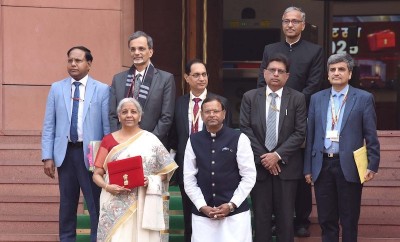 Liquidity infusion
Liquidity infusion
RBI injects Rs 1.1 trillion in largest infusion since Apr 2019
Mumbai: The Reserve Bank of India injected Rs 1.1 trillion into the system on Thursday, marking the largest single-day liquidity infusion since April 24, 2019. This comes amid onset of corporate advance taxes leading to significant outflows from the banking system
Based on its data, the apex bank infused a net liquidity of Rs 110,772 crore into the banking system on March 16.
This marks the first time since April 24, 2019, that the RBI has infused more than Rs 1 trillion into the banking system in a single day.
Due to the restricted availability of funds, there was a significant increase in the rates in the money market, and the interbank call money rate surged to 6.80%, exceeding the repo rate of 6.50% and the MSF rate of 6.75%, which is the upper limit of the interest rate corridor. The elevated call rate indicates an increase in borrowing costs for banks.
On Friday, the weighted average call rate (WACR) was recorded at 6.65%, which is slightly higher than the previous day's rate of 6.52%. The WACR serves as the operational target of the Reserve Bank of India's monetary policy, and the central bank aims to maintain it in alignment with the repo rate by conducting liquidity operations.
Up until March 15, the Reserve Bank of India (RBI) had been absorbing funds from the banking system every day this month, with an average absorption of Rs 51,925 crore. This indicates that there was excess cash available with the banks. However, the recent data reveals that the tax outflows have resulted in a decrease in liquidity, as reflected by the tighter liquidity conditions.
The Reserve Bank of India (RBI) has injected funds into the banking system through various means such as the Marginal Standing Facility (MSF) window, variable rate repo operations, and Standing Liquidity Facility (SLF) borrowings, media reports said.
On March 10, the RBI conducted a 14-day variable rate repo auction in which banks borrowed Rs 82,650 crore. The latest borrowing through the MSF window was Rs 8,664 crore, while the SLF borrowing was Rs 17,239 crore, as per the available data.
In February, RBI relaunched variable rate repo operations after a pause of five months to assist banks in managing the tightening liquidity conditions.
The pressure on liquidity is being intensified not only due to tax outflows at the end of the fiscal year but also due to the redemption of pandemic-era repo operations worth a total of Rs 73,412 crore from March 17 to April 21.
The liquidity surplus in the banking system, which was around Rs 7.4 trillion in April 2022, reduced to Rs 1.6 trillion during December-January. To tackle high inflation, the RBI has been withdrawing monetary accommodation since May 2022.
Support Our Journalism
We cannot do without you.. your contribution supports unbiased journalism
IBNS is not driven by any ism- not wokeism, not racism, not skewed secularism, not hyper right-wing or left liberal ideals, nor by any hardline religious beliefs or hyper nationalism. We want to serve you good old objective news, as they are. We do not judge or preach. We let people decide for themselves. We only try to present factual and well-sourced news.







